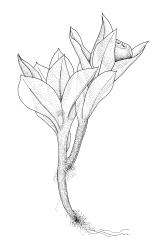- ≡ Gymnostomum subgen. Physcomitrium Brid., Bryol. Univ. 1, 97 (1826)
Plants small to medium sized, gregarious, pale green. Stems red-brown, less commonly brown or pale, usually branched once by subperigonial innovation, very short to 10 mm or more, in cross-section with a parenchymatous medulla and a cortex of 2–3 layers of thick-walled cells, with or without a central strand, beset with red-brown rhizoids, tubers absent in N.Z. species. Leaves erect-spreading, rarely somewhat incurved, more or less concave, larger and more crowded near stem apices, obovate to oblong-lanceolate, acuminate, acute or obtuse; margins plane, toothed above or rarely entire; upper laminal cells thin-walled, oblong-hexagonal, rarely short oblong or more or less quadrate, in lower portion longer and more oblong; marginal cells usually longer and narrow, not forming a distinct border in N.Z. species. Costa ending well below apex to subpercurrent, rarely shortly excurrent.
Autoicous in N.Z. species, rarely paroicous, polygamous, or synoicous. Perigonia single, terminating a shoot from which the female branch arises by innovation. Setae red-brown or yellow, <0.5 mm to c. 15 mm, smooth, straight; capsules erect, pyriform to hemispheric or globose, operculate, gymnostomous, neck variably developed; mouth transverse, as wide as the capsule or rarely strongly narrowed; often becoming flared with age; exothecial cells isodiametric to shortly oblong, firm- or rarely thin-walled, non-cuneate, weakly to markedly thickened at corners, few to several suboral rows oblate and with thickened transverse walls; annulus composed of a single row of thin-walled cells with a thick distal transverse wall, rarely vesicular, or of more than one ring of cells and revoluble; stomata variably immersed. Operculum plano-convex and rostrate, rarely conic. Calyptra mitrate-rostrate, covering less than half the capsule and falling before maturity. Spores subreniform, red-brown, spinose.
The spores are consistently spinose in Physcomitrium. The non-cuneate exothecial cells are sometimes useful in distinguishing Physcomitrium from gymnostomous species of Entosthodon, although regionally such confusion is unlikely. Given the absence of peristome characters in this genus, there has been considerable emphasis on capsule form (see Fife 1985, pl. 11), as well as a limited range of gametophytic differences, to differentiate species. As a consequence many geographically isolated populations have been unduly dignified with specific rank. Clarification of the relationships within Physcomitrium (which is likely not monophyletic) is not possible using morphological features alone.
A genus of probably more than 50 species, widely distributed in temperate and, to a lesser extent, tropical regions. Only two species are accepted for N.Z.
| 1 | Setae 0.1–0.5 mm; capsules nearly globose and with a mouth c. ⅓ the capsule diameter; spores ≥37 μm diameter; very rare and known only north of 38° S | P. pusillum |
| 1' | Setae 3–6 mm; capsules globose-pyriform, with mouth as wide as capsule and usually becoming flared with age; spores 27–39 μm diameter; common and widespread | P. pyriforme |
| Category | Number |
|---|---|
| Indigenous (Non-endemic) | 1 |
| Exotic: Fully Naturalised | 1 |
| Total | 2 |
Physcomitrium perrottetii Mont. was cited from the Bay of Islands by Wilson (1854, p. 92). This species is not listed in Tropicos (Data seen online, TROPICOS, accessed 12 Jul. 2017). Dixon (1926) rejected the inclusion of this apparently Indian species in the N.Z. flora, and this taxon is not considered further here.
Physcomitrium pyriforme var. pumilum Hook.f. & Wilson [Bot. Antarct. Voy II (Fl. Nov.-Zel.) Part II 92, 1854], was described from the Bay of Islands; type material has not been seen. Dixon (1926, p. 193) reported seeing a scrap collected by C. Knight and labelled as this variety by Mitten at Kew. No useful purpose would be served by questioning Dixon’s decision to place it in the synonymy of P. conicum (which is considered a synonym of P. pyriforme here).




